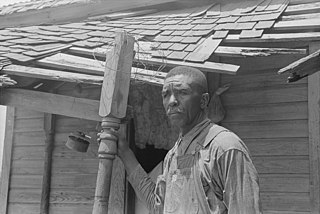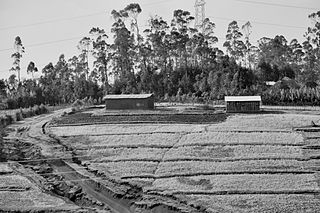Related Research Articles
Agrarianism is a social and political philosophy that has promoted subsistence agriculture, family farming, widespread property ownership, and political decentralization. Adherents of agrarianism tend to value traditional bonds of local community over urban modernity. Agrarian political parties sometimes aim to support the rights and sustainability of small farmers and poor peasants against the wealthy in society.

A peasant is a pre-industrial agricultural laborer or a farmer with limited land-ownership, especially one living in the Middle Ages under feudalism and paying rent, tax, fees, or services to a landlord. In Europe, three classes of peasants existed: non-free slaves, semi-free serfs, and free tenants. Peasants might hold title to land outright, or by any of several forms of land tenure, among them socage, quit-rent, leasehold, and copyhold.

Enclosure or inclosure is a term, used in English landownership, that refers to the appropriation of "waste" or "common land" enclosing it and by doing so depriving commoners of their rights of access and privilege. Agreements to enclose land could be either through a formal or informal process. The process could normally be accomplished in three ways. First there was the creation of "closes", taken out of larger common fields by their owners. Secondly, there was enclosure by proprietors, owners who acted together, usually small farmers or squires, leading to the enclosure of whole parishes. Finally there were enclosures by Acts of Parliament.

A tenant farmer is a person who resides on land owned by a landlord. Tenant farming is an agricultural production system in which landowners contribute their land and often a measure of operating capital and management, while tenant farmers contribute their labor along with at times varying amounts of capital and management. Depending on the contract, tenants can make payments to the owner either of a fixed portion of the product, in cash or in a combination. The rights the tenant has over the land, the form, and measures of payment vary across systems. In some systems, the tenant could be evicted at whim ; in others, the landowner and tenant sign a contract for a fixed number of years. In most developed countries today, at least some restrictions are placed on the rights of landlords to evict tenants under normal circumstances.

The Irish National Land League, or commonly the "Land League", was an Irish political organisation of the late 19th century which organised tenant farmers in their resistance to exactions of landowners. Its primary aim was to abolish landlordism in Ireland and enable tenant farmers to own the land they worked on. The period of the Land League's agitation is known as the Land War. Historian R. F. Foster argues that in the countryside the Land League "reinforced the politicization of rural Catholic nationalist Ireland, partly by defining that identity against urbanization, landlordism, Englishness and—implicitly—Protestantism." Foster adds that about a third of the activists were Catholic priests, and Archbishop Thomas Croke was one of its most influential champions.

Sharecropping is a legal arrangement with regard to agricultural land in which a landowner allows a tenant to use the land in return for a share of the crops produced on that land.
Land reform in South Vietnam refers to reforms proposed by the United States and implemented by South Vietnam. Seeking to undermine the popularity of the communist Việt Minh's policies of land redistribution to poor peasants, the government of South Vietnam implemented their own land-redistribution policies during the Vietnam War.

Agriculture in the Empire of Japan was an important component of the pre-war Japanese economy. Although Japan had only 16% of its land area under cultivation before the Pacific War, over 45% of households made a living from farming. Japanese cultivated land was mostly dedicated to rice, which accounted for 15% of world rice production in 1937.

The Southern Tenant Farmers Union (STFU) (1934–1970) was founded as a civil farmer's union to organize tenant farmers in the Southern United States. Many such tenant farmer sharecroppers were Black descendants of former slaves.
Sino-American Joint Commission on Rural Reconstruction is a commission established in 1948 in mainland China. After the Chinese Civil War, the JCRR then moved to Taiwan, where its work has been widely credited with laying the agricultural basis in the 1950s and 1960s for Taiwan's outstanding economic growth in the following decades by a coordinated program of economic, social, and technical development.
Operation Barga was a land reform movement, throughout rural West Bengal for recording the names of sharecroppers (bargadars) while avoiding the time-consuming method of recording through the settlement machinery. It bestowed on the bargadars, the legal protection against eviction by the landlords (jotedars), and entitled them to the due share of the produce. Operation Barga was launched in 1978 and concluded by the mid-1980s. Introduced in 1978, and given legal backing in 1979 and 1980, Operation Barga became a popular but controversial measure for land reforms. The ultimate aim of these land reforms was to facilitate the conversion of the state's bargadars into landowners, in line with the Directive Principles of State Policy of the Indian Constitution. To date, Op Barga has recorded the names of approximately 1.5 million bargadars. Since then, it has been marked as one of the most successful land reforms programs in India.

The problem of land reform in Ethiopia has hampered that country's economic development throughout the late 19th and 20th centuries. Attempts to modernize land ownership by giving title either to the peasants who till the soil, or to large-scale farming programs, have been tried under imperial rulers like Emperor Haile Selassie, and under Marxist regimes like the Derg, with mixed results. The present Constitution of Ethiopia, which was put into force January 1995, vests land ownership exclusively "in the State and in the peoples of Ethiopia." The relevant section continues, "Land is a common property of the Nations, Nationalities and Peoples of Ethiopia and shall not be subject to sale or to other means of exchange." Despite these different approaches to land reform, Ethiopia still faces issues of sustainable food self-sufficiency.
Crop share rent is a proportion of the crop harvest (yield) to be paid by the tenant farmer to the land owner as compensation for occupying and exploiting the rented land.
The Comprehensive Agrarian Reform Program, more commonly known as CARP, is an agrarian reform law of the Philippines whose legal basis is the Republic Act No. 6657, otherwise known as the Comprehensive Agrarian Reform Law (CARL). It is the redistribution of private and public agricultural lands to help the beneficiaries survive as small independent farmers, regardless of the “tenurial” arrangement. Its goals are to provide landowners equality in terms of income and opportunities, empower land owner beneficiaries to have equitable land ownership, enhance agricultural production and productivity, provide employment to more agricultural workers, and put an end to conflicts regarding land ownership.

The Oriental Development Company was a colonial company established by the Empire of Japan in 1908. The company was headquartered first in Seoul, and later in Tokyo.
Agrarian reform and land reform have been a recurring theme of enormous consequence in world history. They are often highly political and have been achieved in many countries.
Land reform in the Philippines has long been a contentious issue rooted in the Philippines's Spanish Colonial Period. Some efforts began during the American Colonial Period with renewed efforts during the Commonwealth, following independence, during Martial Law and especially following the People Power Revolution in 1986. The current law, the Comprehensive Agrarian Reform Program, was passed following the revolution and extended until 2014.
Land reform in Vietnam began in the political turmoil following World War II in which a civil war pitted the communist Viet Minh against the French colonists and their supporters. At that time a large percentage of agricultural land was owned by large landowners and the majority of the rural population of Vietnam owned only small plots of land or was landless. The early success of the land reform program of the Viet Minh, gave the communists a strong base of support among the 80 percent of the Vietnamese people who lived in rural areas. The support of the communists by a large number of rural dwellers was an important factor in determining the outcome of the Vietnam War.
Concentration of land ownership refers to the ownership of land in a particular area by a small number of people or organizations. It is sometimes defined as additional concentration beyond that which produces optimally efficient land use.
The 37.5% Arable Rent Reduction Act is a law enacted by the Republic of China (Taiwan) on 25 May 1951. The act was proposed by Jiang Menglin of the JCRR on Apr 14 1949 to Chen Cheng, the Provincial Governor of Taiwan. The act was eventually passed by the Legislative Yuan on 25 May 1951.
References
- ↑ Koo, Anthony Y. C. (1966-03-01). "Economic Consequences of Land Reform in Taiwan". Asian Survey. 6 (3): 150–157. doi:10.2307/2642219. ISSN 0004-4687. JSTOR 2642219.
- 1 2 3 BOWDEN, THOMAS R. (1961). "Land Reform and Rural Development on Taiwan". University College Review. 1 (1): 34–40. ISSN 2310-3973. JSTOR 41965668.
- ↑ 土地改革紀念館 [Land Reform Museum] (in Chinese). Archived from the original on 2011-07-25.
- ↑ "Foreign Relations of the United States, 1948, The Far East: China, Volume VIII - Office of the Historian". history.state.gov. Retrieved 2023-02-20.
- ↑ 國家發展委員會:三七五減租 (Farmland Rent Reduction) Archived 2014-11-29 at the Wayback Machine